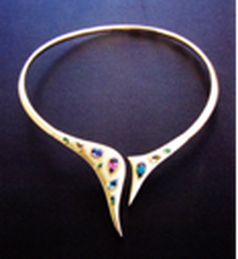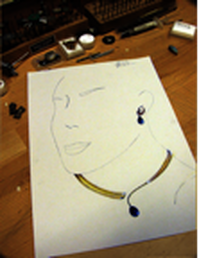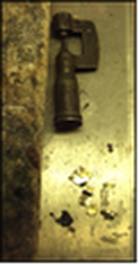GUNTER STEINSCHERER
MASTER GOLDSMITH
Wearing jewellery has been a feature of humankind from our earliest history. Before we could shape metal or carve stone, our ancestors adorned their bodies with simple beads made from seeds and shells and later from bones and animal teeth. The breakthrough came when we learned to work with metals - gold being the favourite, prized for its rarity, beauty and malleability.
It is from a historical aspect - albeit much more recent that Gunter Steinscherer creates his contemporary, avant-garde jewellery. That might sound like something of a contradiction, but by using techniques dating from the 15th and 16th centuries - his work possesses a lucidity and a freedom from another time, making his light, airy pieces in precious metal look refreshingly modern. The term studio jewellery has crept into the vocabulary of the trade. It is frequently used to distinguish artists' work from those produced purely for commercial outlets. Gunter quickly made that distinction about himself, and a fleeting glance around his studio suggests it an accurate description.
He grew up near the small Austrian town of Graz, close to the border with Italy. "Austria is not very big, and most of the population wants to live in Vienna", he told me. "But I grew up in the country, close to some magnificent mountains, surrounded by fabulous lakes. My father was a ski instructor, and I first skied when I was about three. But the artistic line comes from my grandmother and her father, both painters. I always had an interest in art at school. When the opportunity of an apprenticeship in goldsmithing came up, I grabbed the chance to study."
Gunter embraced the subject with such passion he became a Master Goldsmith by the age of 20 - the youngest Master Goldsmith ever. "I lived my work, I suppose - my friends had other interests while I simply breathed the jewellery business. Soon, I had my own shop, buying and selling jewellery and, of course, the other functions a shop performs."
At the time, his hometown of Graz was well off the tourist map - a quiet country town enjoyed by local people. His business did well, though, but he needed time to experiment and create one-off pieces and to do that, he needed a wider audience. The work he produced for the exhibition circuit led to a great demand for more and allowed him to give up the shop to concentrate on his own work.
Gunter now divides his time between his studio in Austria and the studio he has here in the Forest. "You know I have been fortunate; one of my regular clients first saw my work at an exhibition in my home town in Austria. Eventually, we became friends, and I was invited to stay with him and his family in the New Forest. I just fell in love with the place, and now I have somewhere of my own here. I can go back and forth between my studios, meeting clients in both countries."
Working from a solid block of gold, he creates his own unique cocktail - all his work is 18 carat, and everything is fashioned by hand, even the tiny fixing pins, springs and minute hinges. He incorporates fine gemstones and diamonds in his composites, sourced from around the world. "I have a Hungarian contact who owns a small opal mine in Australia. He lets me have some very rarely found stones. There are mines in Europe where you will find only certain colours. I get excited with a rare find. It makes the final piece much more special."
Jewellery design appears to flow in two directions simultaneously; while one follows established styles and materials that have evolved over decades, there are those innovators who are more the artist - approaching their work more as a means of self-expression than a commercial venture. They challenge the notion of what jewellery is by using new materials or how they are worked and through radically different forms. Gunter Steinscherer certainly falls into the latter category. His work is revolutionary in every respect, balancing the relationship between jewellery and the body, creating beautiful structures from solid gold which appear more as sculpture.
THIS ARTICLE FIRST APPEARED IN 'THE NEW FOREST COUNTRY MAGAZINE'
It is from a historical aspect - albeit much more recent that Gunter Steinscherer creates his contemporary, avant-garde jewellery. That might sound like something of a contradiction, but by using techniques dating from the 15th and 16th centuries - his work possesses a lucidity and a freedom from another time, making his light, airy pieces in precious metal look refreshingly modern. The term studio jewellery has crept into the vocabulary of the trade. It is frequently used to distinguish artists' work from those produced purely for commercial outlets. Gunter quickly made that distinction about himself, and a fleeting glance around his studio suggests it an accurate description.
He grew up near the small Austrian town of Graz, close to the border with Italy. "Austria is not very big, and most of the population wants to live in Vienna", he told me. "But I grew up in the country, close to some magnificent mountains, surrounded by fabulous lakes. My father was a ski instructor, and I first skied when I was about three. But the artistic line comes from my grandmother and her father, both painters. I always had an interest in art at school. When the opportunity of an apprenticeship in goldsmithing came up, I grabbed the chance to study."
Gunter embraced the subject with such passion he became a Master Goldsmith by the age of 20 - the youngest Master Goldsmith ever. "I lived my work, I suppose - my friends had other interests while I simply breathed the jewellery business. Soon, I had my own shop, buying and selling jewellery and, of course, the other functions a shop performs."
At the time, his hometown of Graz was well off the tourist map - a quiet country town enjoyed by local people. His business did well, though, but he needed time to experiment and create one-off pieces and to do that, he needed a wider audience. The work he produced for the exhibition circuit led to a great demand for more and allowed him to give up the shop to concentrate on his own work.
Gunter now divides his time between his studio in Austria and the studio he has here in the Forest. "You know I have been fortunate; one of my regular clients first saw my work at an exhibition in my home town in Austria. Eventually, we became friends, and I was invited to stay with him and his family in the New Forest. I just fell in love with the place, and now I have somewhere of my own here. I can go back and forth between my studios, meeting clients in both countries."
Working from a solid block of gold, he creates his own unique cocktail - all his work is 18 carat, and everything is fashioned by hand, even the tiny fixing pins, springs and minute hinges. He incorporates fine gemstones and diamonds in his composites, sourced from around the world. "I have a Hungarian contact who owns a small opal mine in Australia. He lets me have some very rarely found stones. There are mines in Europe where you will find only certain colours. I get excited with a rare find. It makes the final piece much more special."
Jewellery design appears to flow in two directions simultaneously; while one follows established styles and materials that have evolved over decades, there are those innovators who are more the artist - approaching their work more as a means of self-expression than a commercial venture. They challenge the notion of what jewellery is by using new materials or how they are worked and through radically different forms. Gunter Steinscherer certainly falls into the latter category. His work is revolutionary in every respect, balancing the relationship between jewellery and the body, creating beautiful structures from solid gold which appear more as sculpture.
THIS ARTICLE FIRST APPEARED IN 'THE NEW FOREST COUNTRY MAGAZINE'



